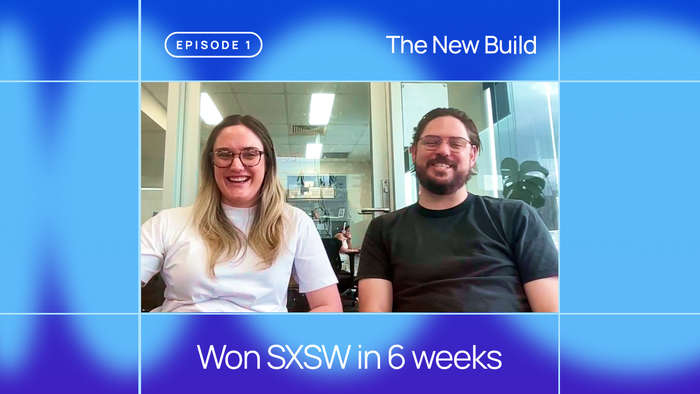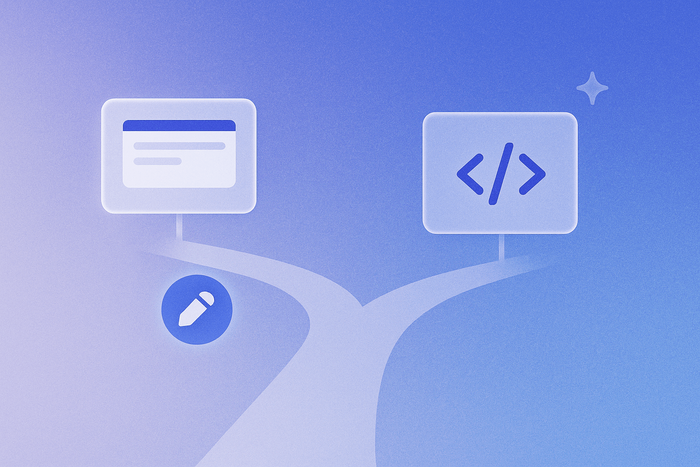About Bubble
Bubble is an industry-leading no-code development platform. For over a decade, we’ve been empowering individuals and organizations to build software quickly and cost-effectively — no matter their level of experience. And the addition of new AI-enabled features makes Bubble easier to use and more powerful than ever. At Bubble, we’re committed to making software development accessible for everyone.
Introduction
No-code has come a long way in the past few years, and it has a bright future ahead. In our 2024 State of No-Code Development Report, we’re taking stock of where things currently stand, providing user feedback and expert opinions on no-code tools, and sharing some predictions on the future of development and no-code.
Here are some examples of the key insights you’ll find:
- The majority of no-code users (64.29%) believe that most human developers will be primarily using no-code solutions to create software applications by 2030.
- A smaller but substantial number of no-code users (40.35%) believe that AI will make traditional human developers largely obsolete by 2030.
- No-code is used heavily by startups, with the majority of founders (80%) planning to bootstrap their funding.
- The most important no-code features according to users are technical performance, customizability, and integrations.
About this report
To create the 2024 State of No-Code Development Report, we surveyed over 350 no-code users across a range of experience levels to learn how they’re using no-code, what’s most important to them, and where they see the future of no-code heading.
Additionally, because Bubble is home to a world-class team of expert engineers and development visionaries who live at the forefront of the no-code world, we sought out their insights and opinions on the state of no-code. You’ll find their thoughts throughout.
Finally, to gain the broadest perspective possible, we also looked to search trends, industry news articles, public statistics, and expert opinions from other organizations to round out our own research and provide you with the definitive state of no-code in 2024.
Predictions about the future of development
To gauge user expectations about how no-code and artificial intelligence (AI) will impact the future of software development, we presented respondents with two scenarios and asked them to rate how likely they thought each statement was to be true.
No-code development by 2030
Respondents were first given the statement “By 2030, the majority of human developers will be primarily using no-code solutions to create software applications.”
The majority of respondents (64.29%) found this statement to be either likely (39.71%) or extremely likely (24.57%), with another 21.71% considering it to be equally likely and unlikely, and the remaining 14.00% finding it either unlikely (12.00%) or not at all likely (2.00%).
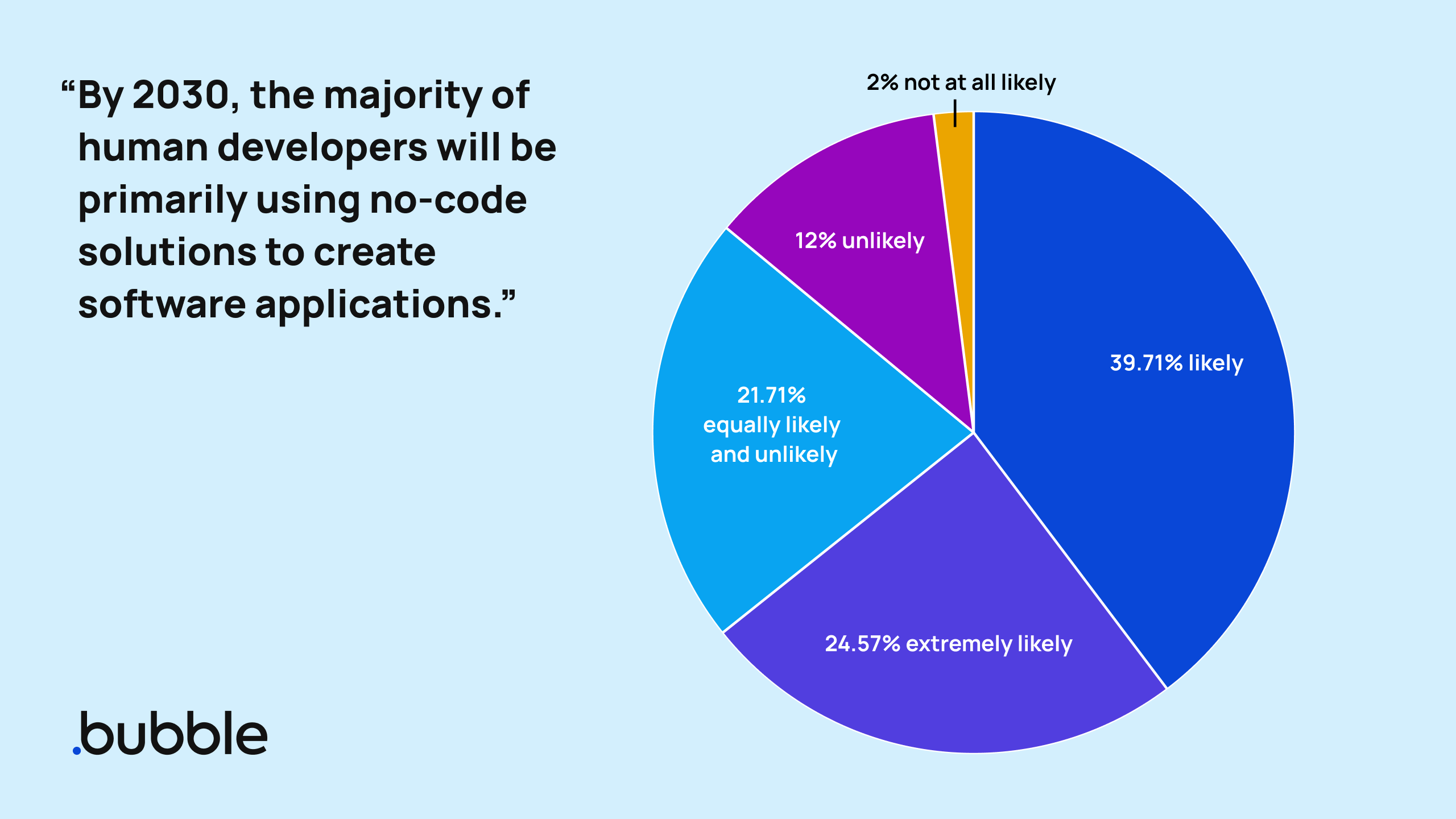
On this note, Bubble VP of Product Allen Yang predicts:
“The development landscape of 2030 will resemble coding today, but we’ll have figured out how to get rid of all the annoying parts of coding: fiddling with syntax, keeping libraries up to date, refactoring code over time. Developers will be working at a higher level of abstraction, and they’ll spend a greater proportion of their time directly creating the actual logic they want to encapsulate in their code.”
And Josh Haas, co-CEO of Bubble, adds:
“The traditional triad of designer, developer, and product manager will have collapsed into a single role, with teams consisting of people who shine on different elements of those skill sets but can work across all three. Configuration and set up of software environments won’t be a thing any more. Batteries-included platforms will be the standard, and application monitoring will supplant infrastructure monitoring.”
AI development by 2030
Respondents were next given the statement “By 2030, AI will make traditional human developers largely obsolete.”
Opinions were much more divided on this scenario, with 40.35% finding this statement to be either likely (27.09%) or extremely likely (13.26%), another 25.07% considering it to be equally likely and unlikely, and 34.58% finding it either unlikely (27.09%) or not at all likely (7.49%).

These responses show high expectations for the future of no-code development overall, even if users are less certain about the extent to which AI will take over.
This also coincides with sentiments from TechRadar, which predicts that no-code and low-code will account for more than 65% of future software development, and from Forbes, which forecasts a 28.3% compound annual growth rate (CAGR) for the no-code AI platform industry from 2023 to 2033.
That being said, Bubble is the primary proponent for merging AI and no-code in the same development platform. A lot of people are trying to use AI to write traditional code. While that’s not a total deadend, our view is that, by comparison, AI has a much more significant impact on no-code development by accelerating the building, iteration, and integration process. In the long term, we see no-code backed by AI functionality largely replacing traditional software development.
Key industry developments and trends
Whatever the future may hold, the data right now shows growing interest in no-code solutions, and particularly no-code enabled by AI.
Increasing awareness and acceptance of no-code solutions
Much of the interest in no-code began during the COVID-19 pandemic. With lockdowns forcing most employees to go remote, scattered teams needed new solutions to manage their operations, and many turned to no-code development to create their own tools. But that interest didn’t end once pandemic restrictions were lifted.
Google search trend data has shown a steady increase in searches for terms like “no-code” and “low-code” from the start of the pandemic lockdowns up to the present day. Searches for “no code platform” in particular have seen a 50% increase from March 1, 2020 to July 1, 2024.
According to a report by Zapier, nearly 60% of custom apps developed in 2022 were built outside of the IT department using no-code or low-code solutions, with that number projected to increase to 70% by 2025. Zapier also reports that 90% of no-code users believe their company has experienced accelerated growth thanks to using no-code.
“The big meta-trend behind all of no-code and pro-code is continuously rising expectations for how easy and fast software development should be. Bubble and all the other tools are in a race to make it as fast and seamless as possible.” — Josh Haas
No-code development has also been responsible for a number of startup success stories. Take Strabo, for example, a fintech startup whose two founders spent only a month building a global personal finance tracker on Bubble’s full-stack no-code platform. Strabo now serves over 10,000 financial institutions in 11 countries, with a valuation of over $1.5 million.
Alongside increasing awareness of successful no-code startups, Carly Rosenkranz expects AI to play a role in shifting skepticism of no-code tools:
“Many entrepreneurs are still skeptical about the benefits of building on no-code platforms, but the widespread adoption of AI is changing expectations about how fast and accessible software development should be. Integrating no-code with AI capabilities is going to accelerate no-code’s transition from a niche toolset to a mainstream solution.”
AI is enhancing no-code development
Recent developments in artificial intelligence (AI) have opened up brand-new possibilities for no-code development.
Starting in December of 2022, Google search trend data shows a surge of interest in terms like “ai app builder” and “ai website builder,” both of which peaked in June of 2023 and have since leveled out to a steady, ongoing interest.
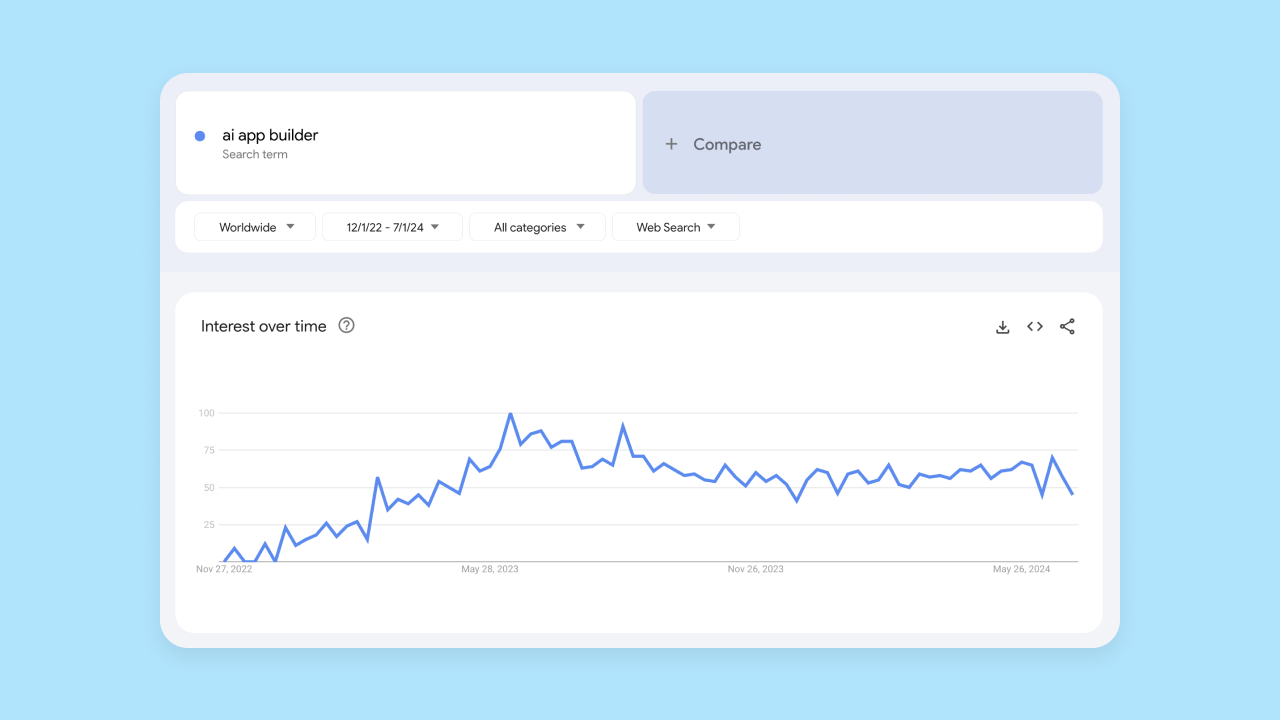
Those search terms represent a mixture of both pro-code and no-code tools. But of the two, AI-enabled no-code has the clear advantage.
“Pro-code solutions enabled by AI leave the non-technical builder at a dead end where they’re unable to edit and iterate on the generated code. But Bubble enabled by AI allows for a back and forth conversation between builder and platform that is editable via drag and drop and visual tweaks. This coming together of technologies is creating a new dynamic and set of circumstances where anyone can prototype, test, and deploy applications easily.”— Carly Rosenkranz
AI-powered natural language prompts can now be used to accomplish tasks like generating the frontend for an app or website. After AI does the suitable heavy lifting, users can take over to complete the process, using no-code development to build out additional functionality. In Bubble’s case, users are also provided with an AI-powered step-by-step guide that’s customized to their specific app’s needs.
This approach of combining AI with no-code makes software development even easier and more accessible than no-code alone, while also further reducing the time it takes to complete a project. Accordingly, we’ve seen a slew of new AI-powered no-code solutions enter the market, like Anakin AI, Druid AI, and Obviously AI. Allen Yang puts it this way:
“People will keep playing with AI-enabled pro-code — only to realize it still doesn’t help people from non-technical backgrounds accomplish what they want. So they’ll turn to no-code. You’ll see the no-code players coming out with more AI-powered features because AI dovetails with their mission to help users create their desired software faster.”
Meanwhile, established no-code platforms like Zapier, Softr, and, of course, Bubble have recently incorporated new AI features into their existing solutions. Carly Rosenkranz explains:
"This shift is not just about adding AI for the sake of novelty, but about fundamentally enhancing the user experience by providing intelligent, context-aware assistance that can streamline workflows and improve productivity. As users interact with these AI-enhanced platforms, they expect seamless integration with other tools and data sources, creating a cohesive and efficient work environment."
According to Forbes, this union of AI and no-code “is not just reshaping the way we approach software development but is also leveling the playing field, allowing everyone from tech novices to experts to harness the power of technological advancement.”
What people are building with no-code
Years ago, it would’ve been easy to assume no-code was a niche solution with limited applications for development. Most people didn’t have much exposure to it, and even experienced software developers were still figuring out what it was capable of. But today, no-code has been used to build everything from highly specialized internal tools to social platforms, marketplaces, AI-powered customer service apps, budgeting apps, and more.
With the most robust no-code platforms, there are few things you can’t build with visual logic. Software that involves allocating and deallocating memory is better suited for programming languages like Assembly and C. And for now, due to its limited 3D modeling capabilities, no-code isn’t well suited for development that requires animation. But that’s not what people are expecting to create with this development approach, either. And since no-code builders like Bubble allow you to write and add custom code when you want to, there are fewer and fewer instances where choosing entirely “full-code” is the best route to your desired outcome.
The recent release of Bubble AI allows users to leverage natural language processing to automatically generate build guides. These build guides provide guidance on how to turn an idea into a working app, including which capabilities they’ll need to include in their software. Analyzing these build guide requests gave us insight into what users are hoping to build with no-code in 2024.
It turns out: People are building just about everything with no-code. Approximate breakdowns based on prompt language reveal findings such as:
- 10% of prompts were focused on ecommerce (store and marketplace)
- 6% of prompts specified “AI” or “artificial intelligence”
- 5% of prompts used social network-related language
- 2% of prompts specified “game”
- 1% of prompts specified “SaaS”
- 1% of prompts specified “dashboard”
- 1% of prompts specified “marketing”
Since no-code development serves such a broad intersection of citizen developers and hobbyists, IT personnel, experienced programmers, and non-technical professionals, the possibilities of what people can build with no-code will only continue to grow in years to come.
Startup funding and no-code
Startups represent some of the most common no-code users. No-code’s speed and affordability compared to traditional development make it highly appealing to founders that want to build software but can’t afford to hire a whole team of developers or wait years to build their app. Whether a startup is backed by VC funding or not, no-code allows teams to be lean and agile enough to execute their ideas far more rapidly with far fewer dev resources, so they can prototype or even create minimum viable products (MVPs) with less time-to-market and tighter deadlines.
Funding is becoming less risky for investors, more risky for founders
The vast majority of pre-seed funding now gives investors a guaranteed stake in the companies they invest in. SAFE — simple agreements for guaranteed equity — have become the norm, which means founders have to exchange long-term control of their business for the short-term gain of capital. This new normal in venture capital fundraising makes affordable, accessible development solutions like no-code more crucial than ever. When founders can dramatically reduce their development costs and timelines, they may be able to avoid this risky tradeoff — or at least depend on it less.
Venture capital funding is returning to pre-COVID-19 levels
While there was a massive drop in VC funding beginning in 2022, it’s largely stabilized, and the current landscape of VC funding looks a lot more like it did before the pandemic. This return to normalcy means securing VC funding is becoming more competitive again, especially considering that new business applications are also growing rapidly. There were a record 5.5 million new business applications filed in 2023.
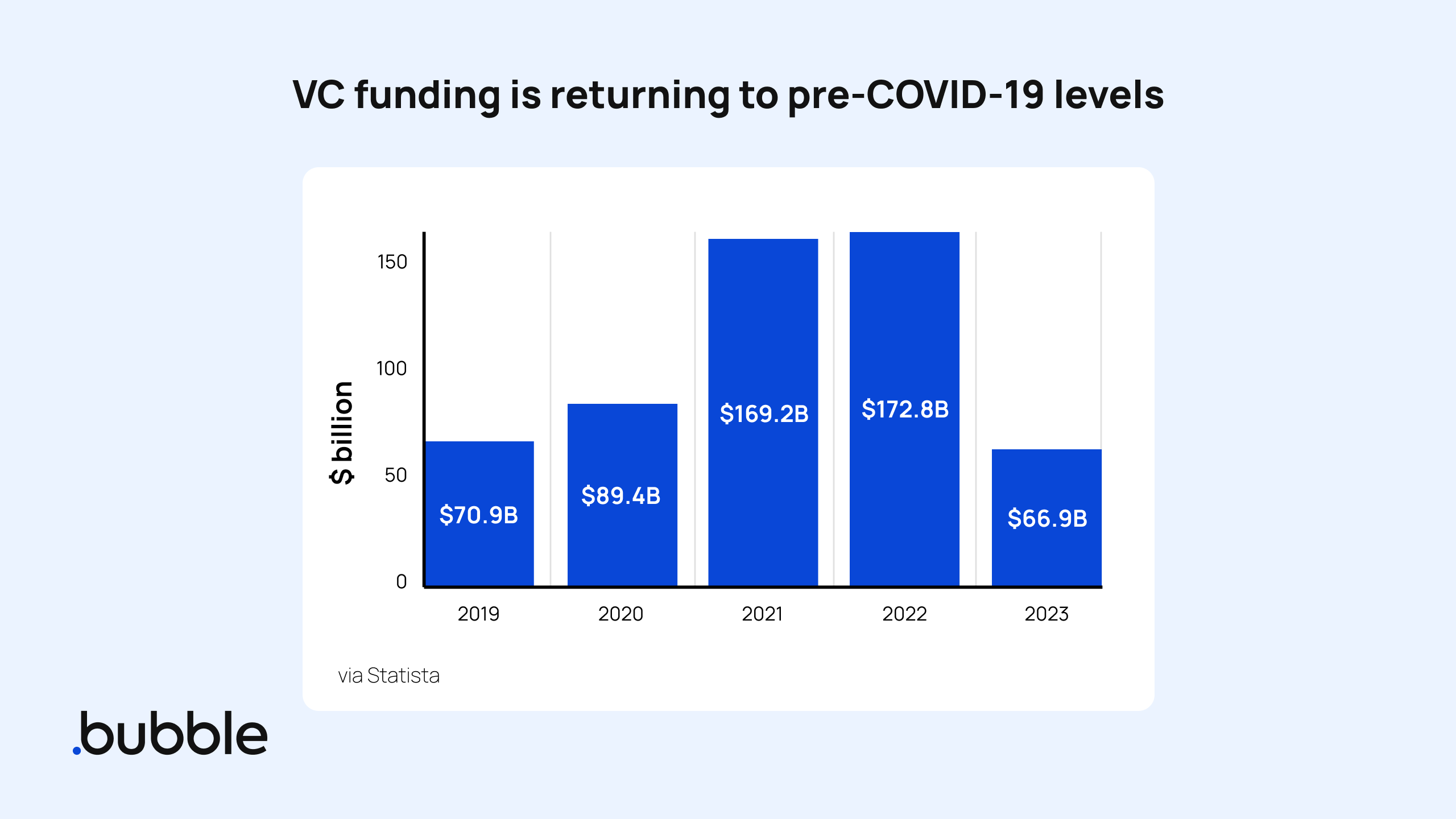
No-code has made starting a tech business and building a product more accessible than ever, but founders may have trouble funding their vision through traditional VC pathways. Unless, perhaps, they’re building something that uses AI.
But VC funding for AI is on the rise
Notably, not all categories are seeing declines in VC funding. AI startups saw a 9% YoY increase in VC investment in 2023, bringing the sector to nearly $50 billion in funds raised. As founders consider the most efficient ways to build their products, it may also be worth considering whether AI would make the product itself more efficient (and appealing to investors).. And those two goals don’t have to be in opposition, either: Leveraging AI doesn’t mean you need to pour more resources into traditional development. You can no-code AI applications, too.
AI is opening the door to “seed strapping”
Scalability is one of the main reasons founders find themselves turning to VC funding. You can’t hire the teams you need to grow without the resources to compensate them. But thanks to AI, founders have new opportunities to grow and scale rapidly without spending resources on additional personnel.
Numra CEO and co-founder David Kearney says, “Whether utilizing chatbots and virtual assistants to handle customer service inquiries or leveraging AI-driven analytics and marketing platforms, startups can now have virtual systems handle tasks that previously required human intervention.”
Much like the way no-code enables startups to produce MVPs more rapidly, leveraging AI for support services empowers startups to create a minimum viable business more rapidly. This has given way to “seed strapping,” where startups raise early rounds of funding and then use AI-based marketing, customer service, and product development services rather than employees to quickly become cash-flow positive.
80% of founders plan to bootstrap
Bootstrapping is a difficult path to funding your business, but it’s also highly rewarding. It gives you more control over your business and enables you to focus on customers’ needs, rather than investors’ interests. In a recent user survey, we asked founders to share how they planned to finance their startup. Here are the results:
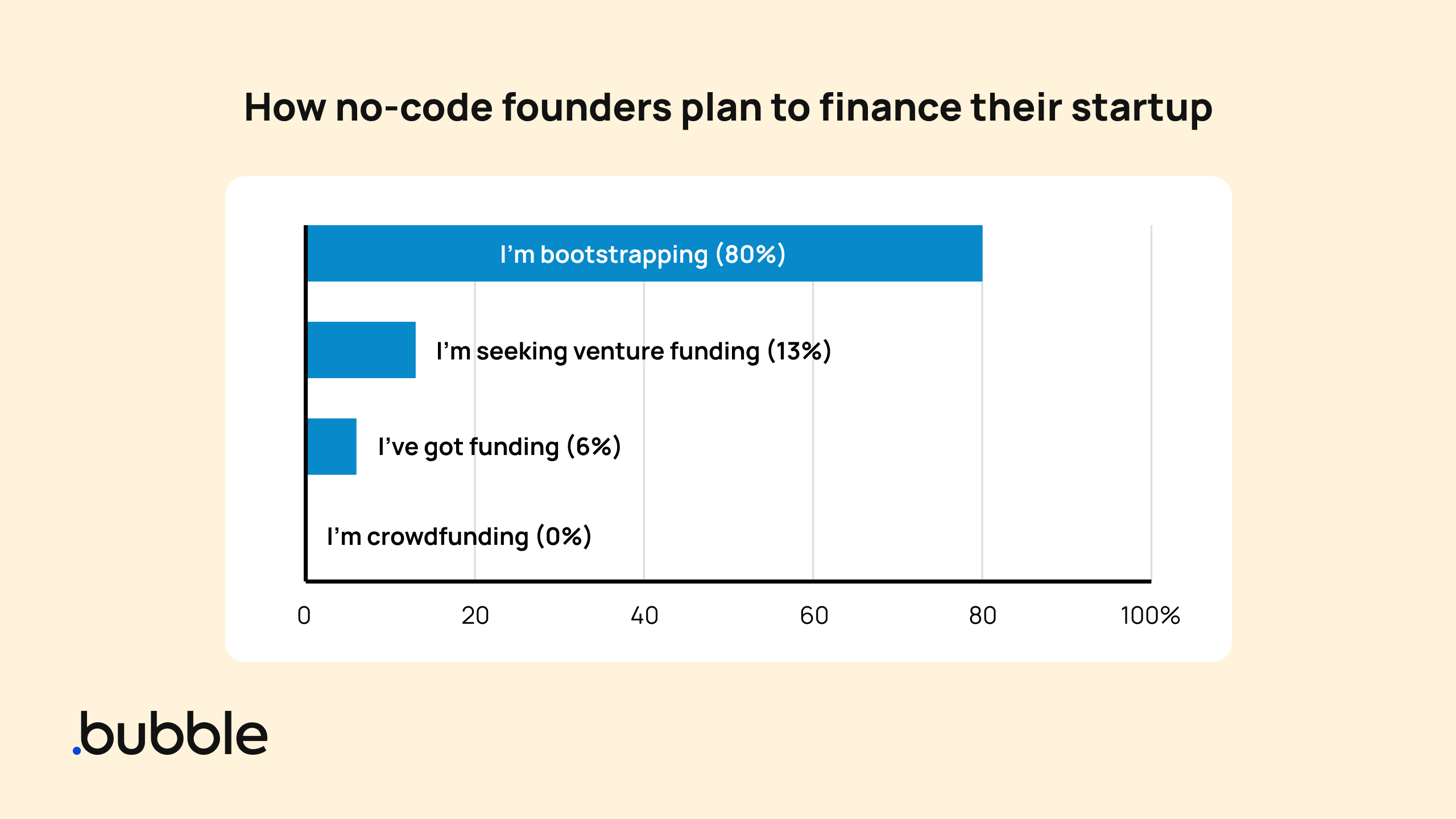
Instead of banking on a huge influx of investment funds and incurring debt, most founders are looking for ways to be as lean and efficient as possible, embracing the slower, more financially risky route of bootstrapping. That’s actually the path Bubble chose, too. In an interview with Indie Hackers, Bubble co-founder Emmanuel Straschnov shared that thanks to bootstrapping, “we had the flexibility to explore and validate as we went without fear of disappointing investors.”
Bootstrapping your business insulates your decision-making process from investors’ doubts as well. “For us, skepticism in the early days was mainly because we were introducing a new category — no-code development,” Straschnov says. “Many people couldn’t grasp the idea that complex applications could be built without traditional coding. . . . But, we saw firsthand the value Bubble was providing to our early users and their early success and enthusiasm fueled our drive. We focused on refining our product, expanding what it could do, educating the market, and slowly but surely, the community started to see the benefits of no-code development.”
2024 audience survey findings
We collected responses from over 350 no-code users about their background, the importance of various features, and predictions about the future of no-code. A free response section also asked them to share about other considerations.
Here’s what we found based on their responses.
2024’s most important no-code features
We asked respondents to rate the importance of 17 features on a scale from one to five to determine what matters most in today’s no-code builders, with one being “not important at all” and five being “extremely important.” Here are the average scores for each factor, in order of importance.
With the lowest average score being 2.94, it’s clear that all 17 features play a key role for some no-code developers when they select a no-code builder. But to get a better grasp of the state of no-code, let’s take a look at the top three most important features, according to our survey of no-code developers.
Technical performance
Rated 4.39/5 on importance
Developers want to know that when they choose a no-code builder, they’re not compromising their product’s performance for the sake of simplicity. They know that with the right tools, they can get both. It doesn’t matter how effortless a no-code platform is if the end result is less usable. Poor performance reflects poorly on developers themselves, and a bad platform can make the convenience of no-code feel like cutting corners.
At Bubble, we consistently optimize our platform’s performance so our users can build better products. Here are just a few examples of how our no-code platform can impact your product’s technical performance:
- Use the right infrastructure for the right job. Bubble tries to run queries on the database, resize images on the server, tell the browser to cache Javascript, etc. as appropriate.
- Build indexes to streamline heavy processes. The first few times you run a particularly heavy search might be a bit slower than future runs, because after Bubble sees a heavy query run a few times, Bubble builds an index that should massively speed up the search in the future (building the index could take up to an hour or so).
- Deduplicate work that appears in multiple places. If a page has the same search in more than one place, Bubble will automatically combine them to run the query once.
Customizability
Rated 4.38/5 on importance
Nobody wants their brilliant new idea to culminate in an app that feels generic or basic. But with some no-code platforms, your customization options are so limited that your software inevitably looks and feels like a reskin of something else.
With modern no-code development, you don’t have to fall back to traditional code for your app or website to fit with your brand. Ease of use doesn’t have to result in cookie-cutter apps. With a comprehensive programming platform like Bubble, you can bring your brand right into the builder, modifying a style template as needed or creating your own from the ground up. And no matter what, you can always extend no-code development with custom code as needed.
“One of the key advantages of democratizing app creation, as Bubble has done, is empowering industry experts to customize software precisely to meet the needs of their users. This often involves implementing logic that goes beyond out-of-the-box solutions or designing UX tailored to specific segments. We’ve seen developers create niche, personalized solutions for audiences like new mothers in France. We’ve also seen job boards and AI-powered resources for individuals navigating immigration processes by helping them obtain visas and learn new languages. These unique solutions simply wouldn’t be possible with off-the-shelf software.” – Rutvij Bhise, Product Marketing Manager at Bubble
Integrations
Rated 4.34/5 on importance
Integrations directly affect your software’s functionality, the kinds of workflows you can create, and ultimately, the no-code tool’s ability to meet your needs. So it’s understandable that this would be a critical consideration when no-code developers select a platform. Making the wrong choice could mean accepting that your software will require additional workarounds outside of the app, or that you’ll have to write some custom code.
This is why integrations used to be an advantage low-code had over no-code: If an app builder didn’t have the built-in integrations you needed, you could at least code them yourself. But today’s full-stack no-code solutions like Bubble have accumulated so many out-of-the-box integrations and simple paths to new ones that you can fully integrate your app or website without touching the backend code. And if you have an especially unique need, Bubble allows you to insert custom code, too.
No-code users
We also asked respondents how they personally use no-code tools, and their answers provided us with insights into different kinds of no-code users, all with their own priorities and preferences. Each of the following profiles represents a specific use case, and respondents could select as many as applied.
The owner
These users selected, “I’m building or managing a business of my own.” Making up 58.86% of respondents, they place the greatest importance on technical performance (4.43), closely followed by free access (4.42) and customizability (4.41). Additionally, they place greater importance on AI capabilities (3.61) than other profiles, though with a 3.49 overall average, it’s of relatively lower importance across the board.
The co-founder
These users selected, “I’m building or managing a business with a co-founder or team.” Making up 28.86% of respondents, they place the greatest importance on technical performance (4.41), scalability (4.37), and integrations (4.31).
The freelance developer
These users selected, “I build no-code apps for others professionally (freelance).” Making up 26.00% of respondents, they place the greatest importance on customizability (4.46), free access (4.42), and integrations (4.40). They place less importance than other profiles on pre-built components and templates (3.26 vs. 3.50 average).
The agency developer
These users selected, “I build no-code apps for others professionally (at an agency).” Making up 17.14% of respondents, they place the greatest importance on customizability (4.47), technical performance (4.42), and integrations (4.32). Although free access is important to all profiles (4.30 average), they place less importance on it (4.14) than other profiles. Agency developers are also the profile least concerned about an expected learning curve (3.37 vs. 3.60 average) and least interested in AI capabilities (3.28 vs. 3.49 average).
The team member
These users selected, “I’m on an internal team managing a no-code tool or app for my employer.” Making up 14.86% of respondents, they place the greatest importance on technical performance (4.59), free access (4.46), customizability (4.35) and scalability (4.35). Although they place more importance on free access than other profiles (4.46 vs. 4.30 average), they place less importance on cost than other profiles (4.00 vs. 4.15 average), suggesting that they’re willing to pay for what works, but need to be sure it works before committing.
The hobbyist
These users selected, “I’m building or managing a no-code app as a hobby.” Making up 23.14% of respondents, they place the greatest emphasis on customizability (4.35), free access (4.31), and integrations (4.27). They place less importance than other profiles on code ownership (3.84 vs. 4.02 average), but greater importance on pre-built components and templates (3.63 vs. 3.55 average). Most respondents who selected the hobbyist profile did so in addition to at least one of the above professional profiles (80.25%), suggesting that they work on their hobby no-code projects on the side of their professional work with no-code.
The tinkerer
These users selected, “I just like to tinker around.” Making up 9.14% of respondents, they place the greatest importance on free access (4.38), code ownership (4.22), integrations (4.19), and cost (4.19). They place more importance on code ownership than other profiles (4.22 vs. 4.02 average), but substantially less importance on a tool’s market reputation (3.09 vs. 3.60 average) or on existing familiarity with a solution (2.94 vs. 3.43 average). Like the hobbyists, most respondents who selected the tinkerer profile did so in addition to professional profiles (81.25%).
Only a tiny fraction of all survey respondents (1.71%) selected just the hobbyist or tinkerer profiles without additional professional profiles.
Level of traditional coding knowledge required
Considering this was a survey of no-code developers about no-code development, it may be surprising that the least important factor in choosing a no-code builder was the level of traditional coding required to use it. But people aren’t choosing no-code solutions because they’re intimidated by traditional coding. They’re choosing no-code because it’s the fastest, easiest way to build software.
“People are talking less about no-code and they’re thinking more about the outcomes they want,” says Allen Yang. “They’re looking for software that manifests their business idea, helps their business run more efficiently, and empowers them to move quickly.”
Based on our survey, this even holds true for people with little to no experience working with traditional code. The respondents who had the least experience with traditional software development were only slightly more likely to assign higher importance to the no-code platform’s “level of traditional coding knowledge required.” And traditional coding knowledge requirements were still the least important factor to this group of respondents.
Development in general is becoming far more accessible. No-code platforms have played a key role in that, but the lack of coding clearly isn’t the biggest appeal of these solutions. People want simple solutions that accelerate the software development process. And if a no-code platform doesn’t have all the other capabilities someone needs — like top-notch technical performance, room for customization, and a variety of integrations — then it won’t be the simplest path to building software that meets your needs.
Educational resources
At the end of survey, respondents were asked to share other factors they consider to be highly important when choosing a no-code platform. Eleven percent of these free responses specifically mentioned some form of educational resources, video guides, walkthroughs, or learning centers.
While no-code builders are designed to be as intuitive as possible, not everyone wants to dive right in and learn through trial and error. Whether they come from third parties or the no-code tool itself , a well-organized library of resources is often the fastest way to learn how to build specific features, implement workflows, and ultimately do exactly what you want on the platform.
No-code doesn’t mean “no learning curve.” Quality, on-demand resources give no-code developers greater confidence in their own abilities and ensure that they won’t need to spend time on Google or in the forums every time they run into a challenge. But these resources also serve another purpose: inspiration. As you increase your exposure to what’s possible within a no-code builder, it opens the door to new ideas you may not have considered before.
People don’t just want to know that a no-code platform can do what they need. They want to know what they can build on it.
Global accessibility and multi-language support
When software development solutions are only accessible to English-speaking developers, the industry cannot reach its true potential for global innovation. Developers shouldn’t have to choose between learning English and building software. And that’s why several respondents referenced the importance of multi-language no-code tools, tutorials, and support.
This isn’t an area all platforms have invested in equally. One respondent specifically noted that Bubble had far more educational content in Japanese than the other options they considered, and that this support was a deciding factor for their team. Bubble currently provides support in 112 languages, and we add more as users request them.
Since early 2024, people have submitted prompts to Bubble AI in 15 different languages. Developers describe their ideas in anywhere from one to several hundred words, and whatever language they use, Bubble AI translates the text into the software features, workflows, and styles people need.
But multi-language support isn’t the only way no-code developers are looking for greater global accessibility. Several respondents also cited a desire for pricing models that take developing nations into account. In countries with weak national currencies, directly translating the cost of a subscription service can create a significant barrier to adoption. While only some vendors currently offer region-specific pricing models, this is a way no-code development could become more accessible to emerging economies in the future. It’s also likely that no-code will continue to simplify website localization, making it easier for developers to publish their sites in multiple languages.
Trust
New no-code tools are emerging all the time. And some no-code app builders are sophisticated enough that you can even use them to build another no-code builder. In other words — anyone can build a no-code platform! And that can make it tricky to find a platform you can trust.
Unlike traditional coding, when you develop an app or build a website with a no-code platform, your software is directly tied to the existence of another company. Numerous free responses to our survey referenced the importance of being able to trust that company to continue to grow, improve their platform, and last well into the future. People want to invest in building on a platform that they know will stick around.
If you’re building a business around a no-code app, ensuring you (and your end users) can trust the platform your app is built on is crucial. No-code developers also wanted to know that the company behind their no-code platform has a product end-of-life plan in place. If the platform were to go under, what would happen to your software? What’s the worst-case scenario?
A developer’s ability to trust a no-code platform vendor also depends on how they approach ownership: when you build software within a platform, do you own your work, or does the vendor? With Bubble, ownership is never in doubt. Everything you make in Bubble is your intellectual property. Every app. All the data. We only own Bubble. And while we intend to continue leading the charge of the no-code revolution in software development, if Bubble ever has to close, we’ll release all our source code under an open source license.
Conclusion
No-code development enables anyone to build software, empowering everyone from hobbyists to startup founders to professional developers. And AI-enabled features are taking the possibilities of no-code development even further.
Bubble is at the forefront of advancing the state of no-code and helping startups succeed in 2024. Whether you’re starting your own business, or just working on a side project, Bubble can help you turn your dreams into reality.
Build for as long as you want on the Free plan. Only upgrade when you're ready to launch.
Join Bubble



